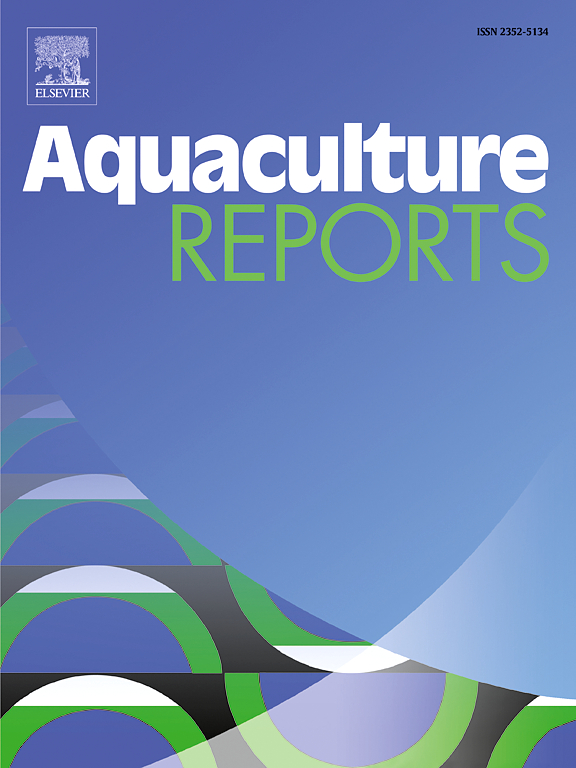饲粮中添加姜黄素对罗氏沼虾生长、抗氧化、转录组和代谢组学的影响
IF 3.2
2区 农林科学
Q1 FISHERIES
引用次数: 0
摘要
在高植物蛋白饲料中加入姜黄素(CU)的影响及其潜在的机制一直没有得到足够的关注。本研究旨在评估罗氏沼虾(Macrobrachium rosenbergii)对高大豆浓缩蛋白(SPC)饲料中不同水平CU的生理反应,考察其生长特性、近似组成、抗氧化能力、免疫、组织病理学、转录组学和代谢组学等因素。饲料配方包括以鱼粉为基础的饲粮(R)、高植物蛋白饲粮(C,用SPC代替60% %的鱼粉)和在C饲粮中添加不同浓度的CU: CU1(1 g/kg)、CU5(5 g/kg)和CU10(10 g/kg)。与R饲料相比,C饲料对罗氏沼虾的生长、近似组成、抗氧化防御或免疫参数没有显著影响。然而,CU10日粮显著提高了最终体重(FBW)、增重和特定生长率(SGR)。CU10组对虾粗脂肪含量最高,其次为C组和CU5组,CU1组最低。此外,CU10日粮显著降低了血淋巴丙二醛(MDA)水平,增加了肠黏膜厚度。肝胰腺转录组分析揭示了9个在治疗过程中显著表达的基因。肝胰腺代谢组学鉴定了三种显著表达代谢物:吉格列汀、阿托醇A和lucuminoside。此外,SPC的替代和CU的加入通过对基因代谢物调控网络的影响来调节“甘油磷脂代谢”。综上所述,在高植物蛋白日粮中添加10 g/kg CU可显著提高生长特性,增强抗氧化能力,改善肝胰脏和肠道健康,同时改善转录组学和代谢组学特征。本文章由计算机程序翻译,如有差异,请以英文原文为准。
The effects of dietary curcumin on growth, antioxidant, transcriptome, and metabolomics in Macrobrachium rosenbergii fed a high plant-protein diet
Insufficient attention has been directed towards the effects of incorporating curcumin (CU) into high plant-protein feeds and the underlying mechanisms at play. This study aims to evaluate the physiological responses of Macrobrachium rosenbergii to varying levels of CU in diets with high soy protein concentrate (SPC), examining factors such as growth characteristics, proximate composition, antioxidant capacity, immunity, histopathology, transcriptome, and metabolomics. Dietary formulations included a fishmeal-based diet (R), a high plant-protein diet (C, with 60 % fishmeal replaced by SPC), and C diets supplemented with CU at different concentrations: CU1 (1 g/kg), CU5 (5 g/kg), and CU10 (10 g/kg). Compared to R diet, the C diet did not significantly alter growth, proximate composition, antioxidant defense, or immune parameters of M. rosenbergii. However, the CU10 diet significantly improved final body weight (FBW), weight gain, and specific growth rate (SGR). Prawns in the CU10 group demonstrated the highest crude lipid content, succeeded by those in the C and CU5 groups, while the CU1 group had the lowest lipid content. Additionally, the CU10 diet reduced hemolymph malondialdehyde (MDA) levels and increased intestinal mucosal thickness significantly. Transcriptome analysis of the hepatopancreas revealed nine significantly expression genes across treatments. Metabolomics of the hepatopancreas identified three significantly expression metabolites across treatments: gemigliptin, artonol A, and lucuminoside. Moreover, the substitution of SPC and the addition of CU regulated ‘glycerophospholipid metabolism’ through their effects on the gene-metabolite regulatory network. In summary, a 10 g/kg CU supplementation in a high plant-protein diet notably augmented growth characteristics, enhanced antioxidant capacity, and improved hepatopancreas and intestinal health, while also refining transcriptome and metabolomics profiles.
求助全文
通过发布文献求助,成功后即可免费获取论文全文。
去求助
来源期刊

Aquaculture Reports
Agricultural and Biological Sciences-Animal Science and Zoology
CiteScore
5.90
自引率
8.10%
发文量
469
审稿时长
77 days
期刊介绍:
Aquaculture Reports will publish original research papers and reviews documenting outstanding science with a regional context and focus, answering the need for high quality information on novel species, systems and regions in emerging areas of aquaculture research and development, such as integrated multi-trophic aquaculture, urban aquaculture, ornamental, unfed aquaculture, offshore aquaculture and others. Papers having industry research as priority and encompassing product development research or current industry practice are encouraged.
 求助内容:
求助内容: 应助结果提醒方式:
应助结果提醒方式:


